I’ve gotta hit you with one more quote from CIO Insight’s brilliant interview with Ricardo Semler. This one’s about IT policies:
One of the things I’ve noticed with this security issue is that IT people want to make sure that their systems are intact, private, confidential “blah, blah, blah” but they think nothing whatsoever of invading the e-mail privacy of their own employees. That’s very interesting to me, because it’s not only a double standard, but a violation of constitutional rights. Companies have taken the blind assumption that because the system is theirs, then anything that people do on it has to be available to them. I think it’s a very hypocritical mode, and it deals with fundamental freedom issues that I don’t think people have completely thought through.
…And what’s most interesting is that we searched far and wide for anybody who could tell us what kind of software or system could be installed on our [server] that would make it impossible for our own IT people to spy on people’s e-mail. We did not find one. We had to customize one.
Imagine that: A company that actually goes out of it’s way to ENSURE that employees’ emails stay private. That is an immensely powerful statement of faith in people.
